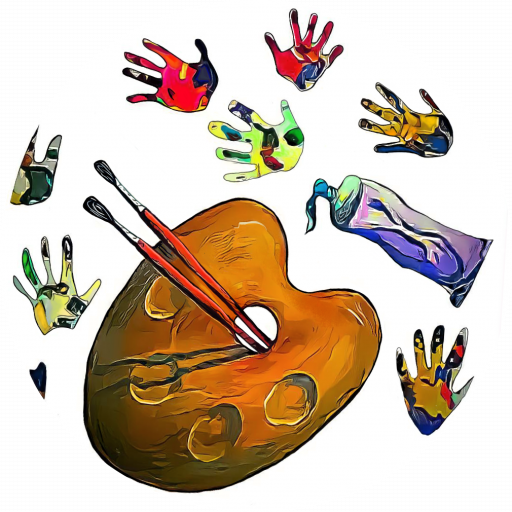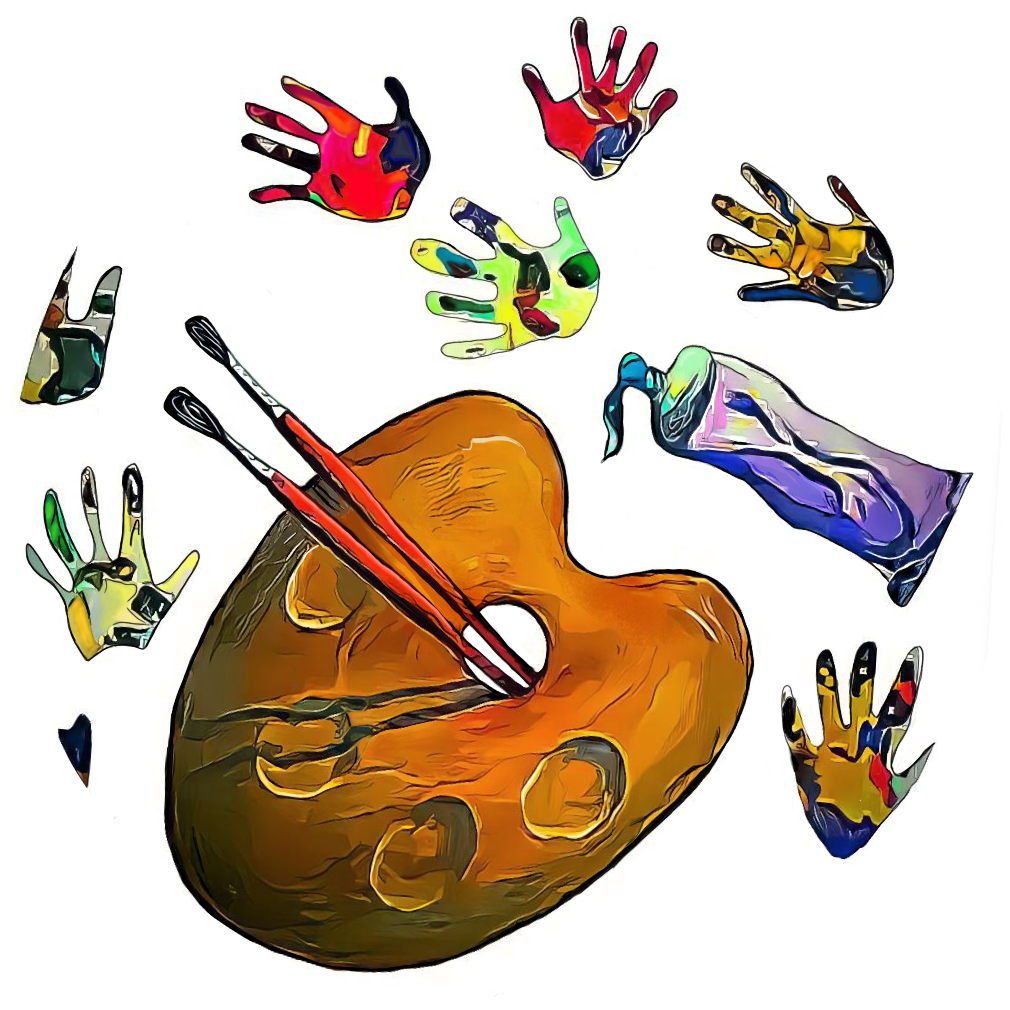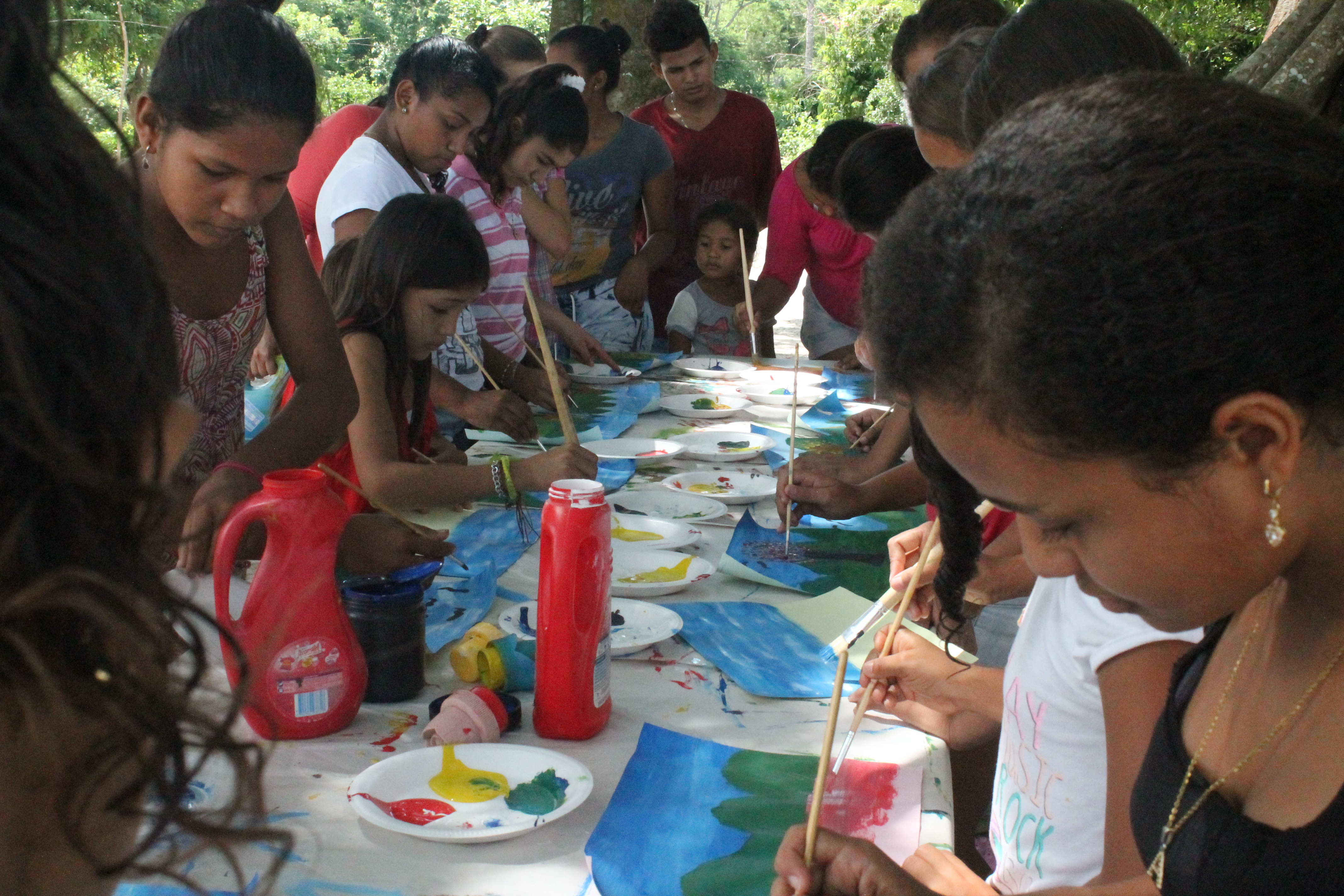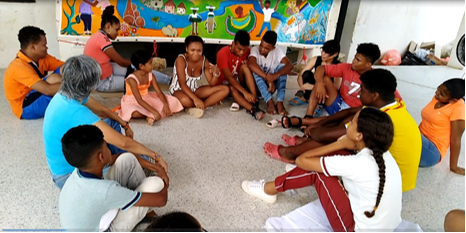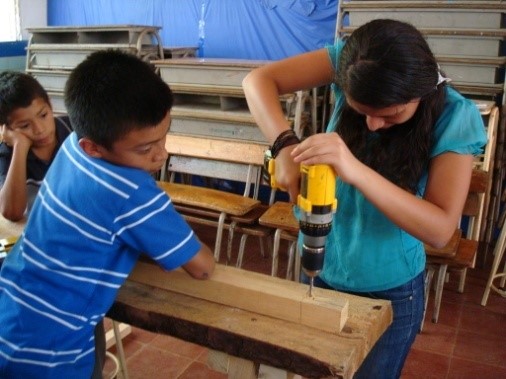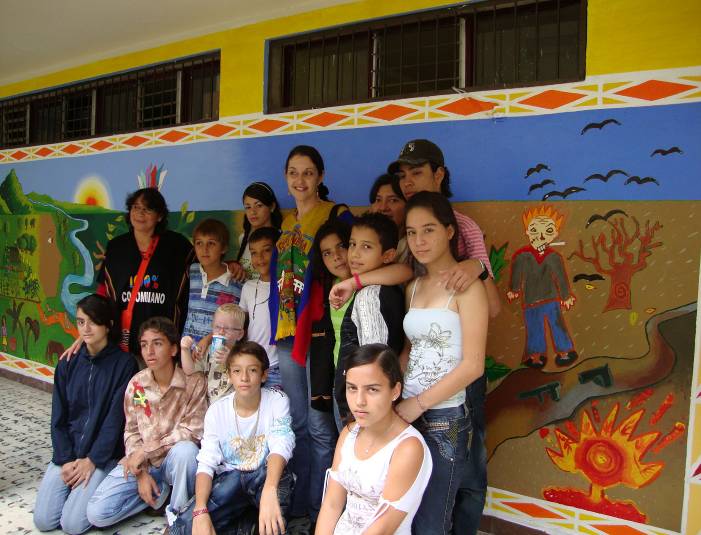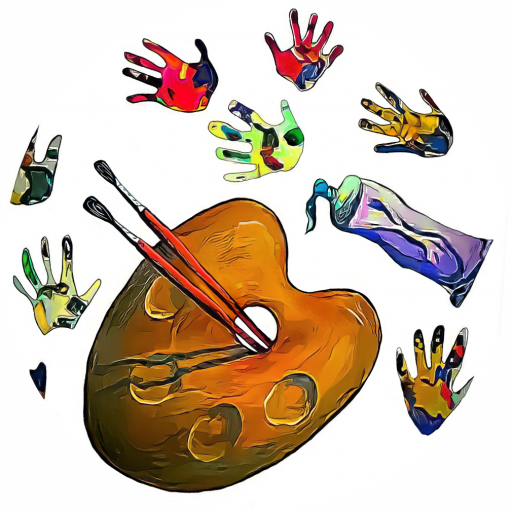Mural at EX –ESMA
November 11-16, 2014
Between November 11th and 16th, twenty five participants representing Mothers of Plaza de Mayo, Grandmothers of Plaza de Mayo, HIJOS and workers from the Public Commission for Memory and the Promotion of Human Rights at EX ESMA created a collaborative mural project located at the House of Mother of Plaza de Mayo, Linea Fundadora in the vestibule that will host the upcoming Music Major for teens and adults, Tecnicatura de Música Popular.
The mural was going to be painted on a surface approximately 6 m in length by 4 meters high.
On November 11th, Claudia Bernardi gave a talk at the National Archive of Memory to introduce the participants to previously completed community based and collaborative projects in El Salvador, Guatemala, Ciudad Juarez, Mexico, and Argentina.
The first step of any project departs from sharing ideas and finding possible threads upon which to edifice the mural theme.
The ideas are drawn and shared and a theme starts taking shape.
This was not an easy task. In part, because the ideas were too BIG, too politically charged and there were too many people who had fantastic ideas that were difficult to edit out.
Enriqueta Marioni, Vera Jarach and Laura Conte, Mothers of Plaza de Mayo Línea Fundadora were part of the founding ideas of the mural.
Finally, a theme was found. Despite the fact that this group of artists did not want to depart from the traditional visual and conceptual structure of past, present and future, they all agreed that in the left side of the mural there would be an open door towards times of conflict, identifying that it was in that location of the mural where there would be an allusion to the military dictatorship.
Once that was agreed upon, the group of participating artists could proceed by applying the first thin layers of colors, “el caldito”
After the thin colors were applied, the process of drawing with chalk started. This is a very important part of the project. By changing the scale from drawing on a page to drawing on the huge surface of the wall, some images take a role as “protagonists” and some others feel unneeded.
The artists looked at the drawings, evaluated, conversed and selected the images that would remain as part of the mural.
Many original drawings form the first stages of ideas did not merge into the upcoming mural. That does not mean that they were not good ideas. What it usually means is that a mural needs areas of silence, places where colors will determine transitions, etc. Thus, many of the original ideas needed to be re-considered.
The selected final drawings were traced on the wall by painting an earth-tinted color line.
Haydée Garcia Gastelú and Vera Jarach provided important questions and ideas that shaped the final theme of the mural.
Laura Conte took brushes and started painting.
Her son, Gonzalo Conte who works for Memoria Abierta at EX ESMA, said that he had not seen her mother paint for the last 40 years.
Collaborative murals usually include multi-generational artists. Laura and the Mothers were the oldest artists in this group. Francisco, son of Anahí Bares, was the youngest. He is 7 years old.
Claudia Bernardi helping Maria to find a way in which and image may meet another one on the mural
What does the mural say? What is the story that the mural tells?
At the left side of the mural the brunches of a tree are missing. The absent top part of the tree extends into a dark night. Bellow the left brunches there is a group of people gathering in a march. Towards the right side of the tree there are red leaves that represent suffering hearts.
The tree is adjacent to an open door that is not inviting. Rather, it implies that the door is the devider between two realities that may never connect again, a vacant space of sorrow.
The suffering tree expands bellow in the form of roots that travel from the extreme left of the mural towards the extreme right side.
The roots become a network of life underneath death.
There is a “knot”, a strunggled force that concentrates under the tree. It represents the history Argentine during the military dictatorship, the ramification of unresolved facts such as the disappeared. Where are they? How could it happen that people were ubducted and eliminated in such a way? How can a country survive such a tragedy?
From the “knot”, a bridge expands upon which people from all ages transit history. They sing and recite stories about the people who had been victims of state terror. They keep memory alive. They are committed to imagine a future that would bring joy, justice, truth and hope.
Water, earth, the roots, nature that has strength and pushes into a new tree crowned by light and a spectrum of colors.
The white scarves represent the Mothers of Plaza de Mayo who have been walking around the Mayo Plaza in front of the Argentine Government house every Thursday since 1977.
This mural is a way to express our thanks to the Mothers of Plaza de Mayo for their monumental task and their tenacity of memory.
When Vera Jarach first came to visit the mural, she suggested that there should be an image representing “their disappeared sons and daughters” in a way that would be “uncontaminated”, protected, as if they could travel safely from past to the present.
It sounded like a wonderful suggestion. Yet, quite challenging. How that sentiment of “protected presence” could be represented?
Roberto, Luz, Cecilia and Azul formed a “Vera Committee” which had the task of investigating and finding a way to translated Vera’s suggestions into a visual from. They came up with the idea of a circle of the same white of the mothers’ scarves. Inside the circles young people, both men and women would be facing the mural, not the viewer. We, the viewers, would be following their gaze into the mural and into their personal and communal stories.
This is the completed mural:
A selected group of the participating artists
Participants:
Workers at Ente Público Espacio para la Memoria y para la Promoción y Defensa de los Derechos Humanos (Ex Esma) Public Commission for Memory and the Promotion of Human Rights at EX ESMA
Carola Gonnet
Carolina Golder
Teresa Orelle
Indiana Goncalves
Adriana Lewi
Sabrina Osowski
Andrés Centrone
Luz Deñisoff
Julieta Saint Girons
Cecilia Dolores Barrios
Roberto Beghe
Ximena Díaz
Susana (de administración)
Ana (de administración)
Andrea Konrat
María Freier
Azul (hija de Cecilia Barrios)
Francisco (hijo de Anahí Bares)
Diego
Olivier
Andres
Mothers of Plaza de Mayo, Linea Fundadora
Vera Jarach
Enriqueta Maroni
Heydée García Gastelú
Laura Conte
Project Director:
Claudia Bernardi
The following references identify the personal stories of the four Mothers of Plaza de Mayo, Linea Fundadora who participated in this project.
Horacio O. García Gastelú – Masacre de Fátima
www.masacredefatima.com.ar/…/index.php?…Translate this page
Mar 25, 2005 – Los Padres de Plaza de Mayo: Oscar García Buela. Eso que no se … El hijo de Haydee García Gastelú y Oscar García Buela. Dos semanas …
www.buenosaires.gob.ar/…/archivo_2_verajarach.htmTranslate this page
VERA VIGEVANI DE JARACH Madre de Plaza de Mayo – Línea Fundadora. Vera Jarach es la mamá de Franca Jarach, detenida – desaparecida el 25 de junio …
Horacio Verbitsky – Página/12 Web :: Buenos Aires, Argentina
www.pagina12.com.ar/…/momentos_clave-horacio_v…Translate this page
Augusto María Conte, detenido-desaparecido mientras cumplía su servicio militar … Laura Jordán de Conte y Angélica Sosa de Mignone, y en compañía de los …
www.buenosaires.gob.ar/…/archivo_Enriqueta.htmTranslate this page
ENRIQUETA MARONI Madre de Plaza de Mayo – Línea Fundadora. Enriqueta Maroni es la madre de Juan Patricio Maroni y María Beatriz Maroni, ambos …
Mural at EX –ESMA
November 11-16, 2014
Between November 11th and 16th, twenty five participants representing Mothers of Plaza de Mayo, Grandmothers of Plaza de Mayo, HIJOS and workers from the Public Commission for Memory and the Promotion of Human Rights at EX ESMA created a collaborative mural project located at the House of Mother of Plaza de Mayo, Linea Fundadora in the vestibule that will host the upcoming Music Major for teens and adults, Tecnicatura de Música Popular.
The mural was going to be painted on a surface approximately 6 m in length by 4 meters high.
On November 11th, Claudia Bernardi gave a talk at the National Archive of Memory to introduce the participants to previously completed community based and collaborative projects in El Salvador, Guatemala, Ciudad Juarez, Mexico, and Argentina.
The first step of any project departs from sharing ideas and finding possible threads upon which to edifice the mural theme.
The ideas are drawn and shared and a theme starts taking shape.
This was not an easy task. In part, because the ideas were too BIG, too politically charged and there were too many people who had fantastic ideas that were difficult to edit out.
Enriqueta Marioni, Vera Jarach and Laura Conte, Mothers of Plaza de Mayo Línea Fundadora were part of the founding ideas of the mural.
Finally, a theme was found. Despite the fact that this group of artists did not want to depart from the traditional visual and conceptual structure of past, present and future, they all agreed that in the left side of the mural there would be an open door towards times of conflict, identifying that it was in that location of the mural where there would be an allusion to the military dictatorship.
Once that was agreed upon, the group of participating artists could proceed by applying the first thin layers of colors, “el caldito”
After the thin colors were applied, the process of drawing with chalk started. This is a very important part of the project. By changing the scale from drawing on a page to drawing on the huge surface of the wall, some images take a role as “protagonists” and some others feel unneeded.
The artists looked at the drawings, evaluated, conversed and selected the images that would remain as part of the mural.
Many original drawings form the first stages of ideas did not merge into the upcoming mural. That does not mean that they were not good ideas. What it usually means is that a mural needs areas of silence, places where colors will determine transitions, etc. Thus, many of the original ideas needed to be re-considered.
The selected final drawings were traced on the wall by painting an earth-tinted color line.
Haydée Garcia Gastelú and Vera Jarach provided important questions and ideas that shaped the final theme of the mural.
Laura Conte took brushes and started painting.
HER SON, GONZALO CONTE WHO WORKS FOR MEMORIA ABIERTA AT EX ESMA, SAID THAT HE HAD NOT SEEN HER MOTHER PAINT FOR THE LAST 40 YEARS.
Collaborative murals usually include multi-generational artists. Laura and the Mothers were the oldest artists in this group. Francisco, son of Anahí Bares, was the youngest. He is 7 years old.
Claudia Bernardi helping Maria to find a way in which and image may meet another one on the mural
What does the mural say? What is the story that the mural tells?
At the left side of the mural the brunches of a tree are missing. The absent top part of the tree extends into a dark night. Bellow the left brunches there is a group of people gathering in a march. Towards the right side of the tree there are red leaves that represent suffering hearts.
The tree is adjacent to an open door that is not inviting. Rather, it implies that the door is the devider between two realities that may never connect again, a vacant space of sorrow.
The suffering tree expands bellow in the form of roots that travel from the extreme left of the mural towards the extreme right side.
The roots become a network of life underneath death.
There is a “knot”, a strunggled force that concentrates under the tree. It represents the history Argentine during the military dictatorship, the ramification of unresolved facts such as the disappeared. Where are they? How could it happen that people were ubducted and eliminated in such a way? How can a country survive such a tragedy?
From the “knot”, a bridge expands upon which people from all ages transit history. They sing and recite stories about the people who had been victims of state terror. They keep memory alive. They are committed to imagine a future that would bring joy, justice, truth and hope.
Water, earth, the roots, nature that has strength and pushes into a new tree crowned by light and a spectrum of colors.
The white scarves represent the Mothers of Plaza de Mayo who have been walking around the Mayo Plaza in front of the Argentine Government house every Thursday since 1977.
This mural is a way to express our thanks to the Mothers of Plaza de Mayo for their monumental task and their tenacity of memory.
When Vera Jarach first came to visit the mural, she suggested that there should be an image representing “their disappeared sons and daughters” in a way that would be “uncontaminated”, protected, as if they could travel safely from past to the present.
It sounded like a wonderful suggestion. Yet, quite challenging. How that sentiment of “protected presence” could be represented?
Roberto, Luz, Cecilia and Azul formed a “Vera Committee” which had the task of investigating and finding a way to translated Vera’s suggestions into a visual from. They came up with the idea of a circle of the same white of the mothers’ scarves. Inside the circles young people, both men and women would be facing the mural, not the viewer. We, the viewers, would be following their gaze into the mural and into their personal and communal stories.
This is the completed mural:
A selected group of the participating artists
Participants:
Workers at Ente Público Espacio para la Memoria y para la Promoción y Defensa de los Derechos Humanos (Ex Esma) Public Commission for Memory and the Promotion of Human Rights at EX ESMA
Carola Gonnet
Carolina Golder
Teresa Orelle
Indiana Goncalves
Adriana Lewi
Sabrina Osowski
Andrés Centrone
Luz Deñisoff
Julieta Saint Girons
Cecilia Dolores Barrios
Roberto Beghe
Ximena Díaz
Susana (de administración)
Ana (de administración)
Andrea Konrat
María Freier
Azul (hija de Cecilia Barrios)
Francisco (hijo de Anahí Bares)
Diego
Olivier
Andres
Mothers of Plaza de Mayo, Linea Fundadora
Vera Jarach
Enriqueta Maroni
Heydée García Gastelú
Laura Conte
Project Director:
Claudia Bernardi
The following references identify the personal stories of the four Mothers of Plaza de Mayo, Linea Fundadora who participated in this project.
Horacio O. García Gastelú – Masacre de Fátima
www.masacredefatima.com.ar/…/index.php?…Translate this page
Mar 25, 2005 – Los Padres de Plaza de Mayo: Oscar García Buela. Eso que no se … El hijo de Haydee García Gastelú y Oscar García Buela. Dos semanas …
www.buenosaires.gob.ar/…/archivo_2_verajarach.htmTranslate this page
VERA VIGEVANI DE JARACH Madre de Plaza de Mayo – Línea Fundadora. Vera Jarach es la mamá de Franca Jarach, detenida – desaparecida el 25 de junio …
Horacio Verbitsky – Página/12 Web :: Buenos Aires, Argentina
www.pagina12.com.ar/…/momentos_clave-horacio_v…Translate this page
Augusto María Conte, detenido-desaparecido mientras cumplía su servicio militar … Laura Jordán de Conte y Angélica Sosa de Mignone, y en compañía de los …
www.buenosaires.gob.ar/…/archivo_Enriqueta.htmTranslate this page
ENRIQUETA MARONI Madre de Plaza de Mayo – Línea Fundadora. Enriqueta Maroni es la madre de Juan Patricio Maroni y María Beatriz Maroni, ambos …
